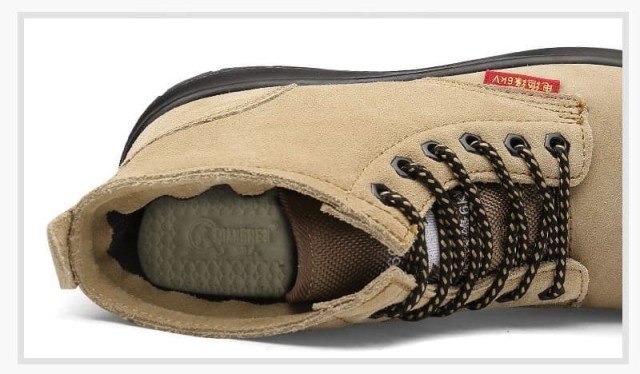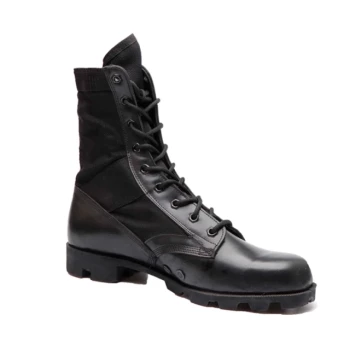Every year, workplace foot injuries cost industries millions in lost productivity and compensation claims—but the right safety boots can prevent most incidents. This guide reveals how to match boot features to your specific hazards, from construction sites to electrical work.
Why Safety Defines Work Boot Quality
Work boots aren’t just about durability; they’re engineered to counteract precise dangers. Research shows that proper safety footwear reduces injury rates by over half in high-risk industries. The difference lies in selecting features aligned with your job’s unique threats.
How Workplace Hazards Dictate Boot Design
- Impact Risks (e.g., falling tools): Require reinforced toe caps (steel or composite) meeting ASTM F2413-18 for compression/impact resistance.
- Electrical Hazards: Demand non-conductive materials (no metal shanks/eyelets) compliant with ASTM F2892-18.
- Slip-Prone Surfaces: Need outsoles with deep treads and soft rubber compounds (ASTM F3445-21) to channel liquids.
Case Example: A study of warehouse workers found slip-resistant soles reduced fall-related injuries by approximately 60% compared to standard boots.
Steel Toe vs. Composite Toe: When to Choose Which
| Feature | Steel Toe | Composite Toe |
|---|---|---|
| Best For | Heavy-impact jobs (construction) | Electrical work, air travel |
| Weight | Heavier (may cause fatigue) | Up to 30% lighter |
| Conductivity | Conducts electricity/cold | Non-conductive |
Tip: Composite toes (made of fiberglass or Kevlar) are ideal for workers passing through metal detectors daily.
Real-World Impact of Proper Safety Selection
Case Study: Construction Site Injury Prevention
A Midwest roofing contractor switched to steel-toe boots with puncture-resistant midsoles after two workers sustained foot injuries from nail penetrations. Over the next year, their recordable incidents dropped by 45%. Key factors:
- Metatarsal Guards: Added protection for the vulnerable upper foot.
- Oil-Resistant Outsoles: Critical for rooftop work with tar and lubricants.
Case Study: Electrical Hazard Mitigation
Utility linemen wearing standard boots faced near-miss shocks until adopting EH-rated (Electrical Hazard) boots. These:
- Use non-metallic materials to block current flow.
- Include dielectric insulation to withstand up to 18,000 volts in dry conditions (per ASTM testing).
Building Your Safety Checklist
Assessing Risks: Questions to Ask Your Employer
- "What ASTM standards does our worksite require?" (e.g., F2413-18 for impact resistance)
- "Are there temperature extremes or chemical exposures?" (Insulation or chemical-resistant linings may be needed.)
- "How often should boots be replaced?" (Worn treads lose 70% of slip resistance.)
Beyond Toe Protection: Slip Resistance and More
- Anti-Fatigue Insoles: Reduce stress for workers standing 8+ hours daily.
- Waterproofing: Essential for outdoor jobs; look for sealed seams and breathable membranes.
- Ankle Support: High-top designs prevent twists in uneven terrain.
Pro Tip: Pair boots with moisture-wicking socks to prevent blisters—a leading cause of missed workdays.
Upgrade Your Safety with 3515’s Custom Solutions
Distributors and bulk buyers: Partner with 3515 to source boots tailored to your clients’ risks—from oil-rig slip resistance to Arctic-grade insulation. Our manufacturing expertise ensures compliance without compromising comfort.
Ready to reduce workplace injuries? [Contact 3515] for scalable safety footwear programs.
Related Products
- Wholesale Customizable Suede Safety Boots - Puncture-Proof with Velcro Closure
- Puncture-Resistant Velcro Safety Boots for Wholesale & Custom Manufacturing
- Durable Leather Moc Toe Work Boots for Wholesale & Custom Manufacturing
- Wholesale Classic Leather Lace-Up Ankle Boots for Brand Manufacturing
- Durable Moc-Toe Wedge Work Boots | Wholesale Manufacturing for Brands
Related Articles
- How to Extend Work Boot Lifespan: Science-Backed Care for Safety & Savings
- How to Choose Work Boots That Match Your Industry's Safety Needs
- How to Choose Work Boots That Match Your Job Demands and Safety Needs
- How to Choose Work Boots That Match Your Job's Safety Demands
- How Safety Work Boots Engineer Protection: Features and Standards for Targeted Hazard Mitigation



















